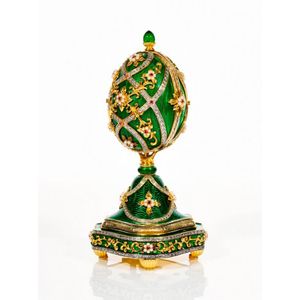Derby Porcelain Pastille Burner with Rural Scenes and Flowers
You must be a subscriber, and be logged in to view price and dealer details.
Subscribe Now to view actual auction price for this item
When you subscribe, you have the option of setting the currency in which to display prices to $Au, $US, $NZ or Stg.
- A/f, as Inspected - The letters "A/F" or "as inspected" as part of a description is the cataloguer's shorthand for "all faults" or "as found", meaning the item has some type of damage or deficiency, it is of uncertain date or provenance, and/or that the seller takes no responsibility for the completeness of the item or the accuracy of the description.
- Finial - An architectural decoration, found on the upper parts of of an object. On furniture they are usually found on pediments, canopies and shelf supports. On smaller ceramic or silver items, such as spoons, they may decorate the top of the item itself, or the lid or cover where they provide a useful handle for removal.
Finials have a variety of shapes and forms. They may be urn-shaped, baluster shaped round or spiral, but usually taper into an upper point. Many real life shapes may also be used as finials, such as pineapples, berries, pinecones, buds, lotus and acorns. Sometimes animals such as a lion are depicted, or fish and dolphins. - Gilding - Gilding is a method of ornamentation whereby a thin sheet of gold metal is applied to items made of wood, leather, ceramics, glass and silver for decorative purposes.
For furniture including mirrors, the sheet of gold is usually applied over a coating of gesso. Gesso is a mixture of plaster of Paris and gypsum mixed with water and then applied to the carved wooden frames of mirrors and picture frames as a base for applying the gold leaf. After numerous coats of gesso have been applied, allowed to dry and then sanded a coat of "bole", a usually red coloured mixture of clay and glue is brushed on and allowed to dry, after which the gold leaf is applied. Over time parts of the gilding will rub off so the base colour can be seen. In water gilding, this was generally a blue colour, while in oil gilding, the under layer was often yellow. In Victorian times, gilders frequently used red as a pigment beneath the gold leaf.
Metal was often gilded by a process known as fire gilding. Gold mixed with mercury was applied and heated, causing the mercury to evaporate, the long-term effect of which was to kill or disable the craftsman or woman from mercury poisoning. The pursuit of beauty has claimed many victims, not the least of which were the artists who made those pieces so highly sought after today. - Grotesque - Grotesque decoration is any fanciful ornament applied to furniture and decorative arts, and includes distorted faces, mythical animals such as satyrs and sphinxes and less frequently fantastical fruit and flower forms.
The Martin Brothers who set up their pottery at the end of the nineteenth century in Southall, Middlesex derived their fame from their hand made models of grotesque stoneware birds.
This item has been included into following indexes:
Visually similar items

A marquetry and gilt bonze mounted long case clock 202 cm high, 50 cm wide

A large Chinese silver gilt and enamel box on stand, the circular serpentine walled box with eight filigree panels with a fitted cover surmounted by a phoenix bird finial, raised on a conforming shaped foot decorated with three further phoenixes, their lon

House of Faberge 'Garden of Jewels' Imperial musical egg crafted in green guilloche enamelled sterling silver, highlighted in 24ct gold, set with 32 rubies, 155 cultured pearls and amethysts, playing Mozart's Magic flute, limited edition. Height 20 cm

A large imperial cast and repousse gilt bronze figure of Buddha Shakyamuni, Qianlong seven character mark and of the period, 18th century, 'Respectfully made in the Qianlong period of the Great Qing Dynasty', seated in Dhyanasana, the hands in Bhumisparsha
